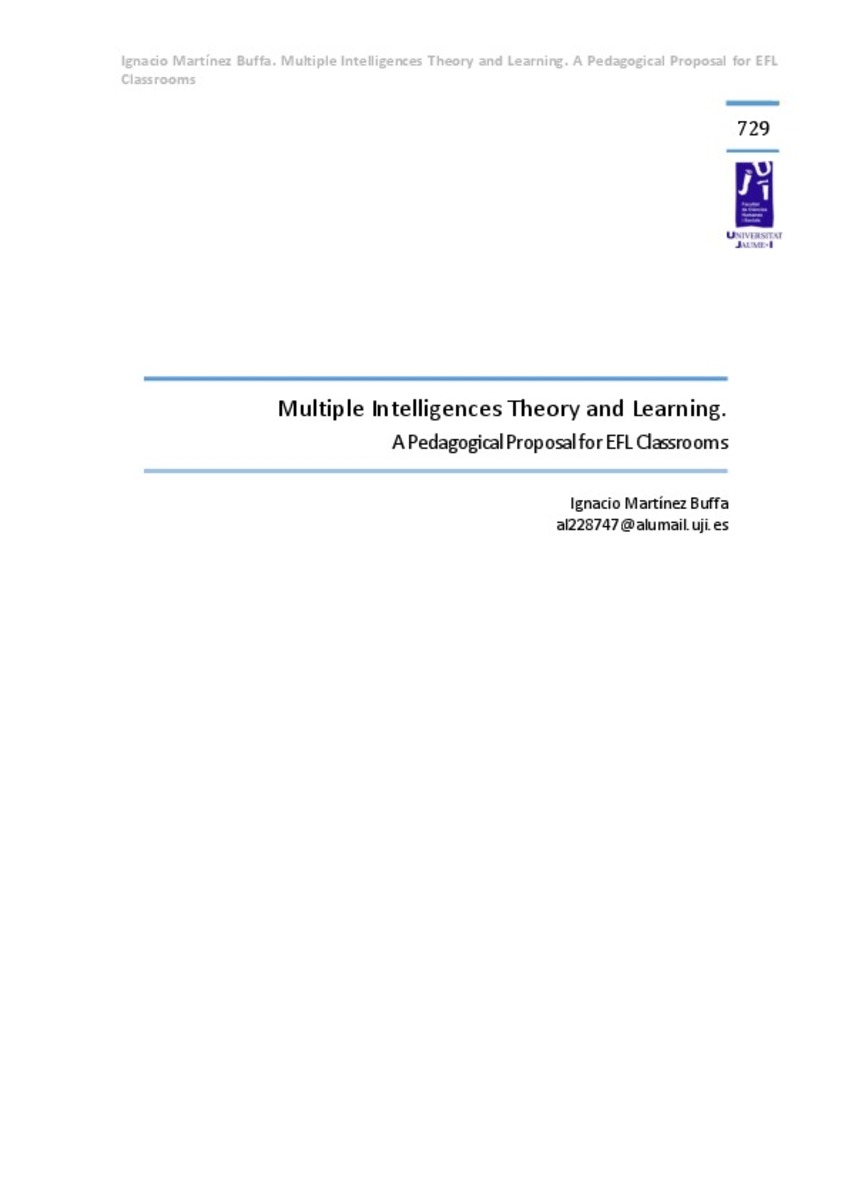Mostrar el registro sencillo del ítem
Multiple intelligences theory and learning. A pedagogical proposal for EFL classrooms
| dc.contributor.author | Martínez Buffa, Ignacio | |
| dc.date.accessioned | 2015-09-17T10:21:53Z | |
| dc.date.available | 2015-09-17T10:21:53Z | |
| dc.date.issued | 2013 | |
| dc.identifier.issn | 1139-5486 | |
| dc.identifier.uri | http://hdl.handle.net/10234/132712 | |
| dc.description | XVIII Jornades de Foment de la Investigació de la Facultat de Ciències Humanes i Socials (Any 2013) | ca_CA |
| dc.description.abstract | It has been shown the relationship of a certain type of cognition with a determined area of the human brain, that is, one particular brain section deals with a specific aptitude and form of processing information. Gardner (1983) formulated the Multiple Intelligence Theory in 1983 and stated the presence of eight different areas in the human brain, each area focusing on a different kind of intelligence. These eight intelligences are: i) the linguistic, ii) the logical-mathematical, iii) the spatial, iv) the bodily- kinaesthetic, v) the musical, vi) the intrapersonal, vii) the interpersonal viii) and the naturalist intelligences. The Multiple Intelligence Theory (henceforth MIT) has major implications on education. Indeed, MIT has changed the teaching methods and has provided better instruments. These intelligences are presented in everybody and students are not the exception to this rule. In fact, learners use their intelligences as means of processing new information. Some students will be more successful in processing new input depending in the form in which this is presented, that is, depending whether this coincides with their developed «intelligence» or «intelligences». Furthermore, with the application of MIT in the classroom students might become leaders of their learning process and teachers might change their profiles as educators by categorizing those common activities, which are usually presented in the classroom. Teachers are no longer seen as figures who transmit knowledge but as motivators of the students’ potential (Antunes, 2000). | ca_CA |
| dc.format.extent | 14 p. | ca_CA |
| dc.format.mimetype | application/pdf | ca_CA |
| dc.language.iso | eng | ca_CA |
| dc.publisher | Universitat Jaume I | ca_CA |
| dc.relation.isPartOf | Fòrum de recerca nº 18, 2013, pp. 729-742 | ca_CA |
| dc.rights.uri | http://creativecommons.org/licenses/by-sa/4.0/ | * |
| dc.subject | Filosofia | ca_CA |
| dc.subject | Filosofía | ca_CA |
| dc.subject | Philosophy | ca_CA |
| dc.subject | Història | ca_CA |
| dc.subject | Historia | ca_CA |
| dc.subject | History | ca_CA |
| dc.subject | Art | ca_CA |
| dc.subject | Arte | ca_CA |
| dc.subject | Arts | ca_CA |
| dc.subject | Educació | ca_CA |
| dc.subject | Educación | ca_CA |
| dc.subject | Education | ca_CA |
| dc.subject | Ciències de la Comunicació | ca_CA |
| dc.subject | Ciencias de la Comunicación | ca_CA |
| dc.subject | Communication Sciences | ca_CA |
| dc.subject | Filologia | ca_CA |
| dc.subject | Filología | ca_CA |
| dc.subject | Filology | ca_CA |
| dc.subject | Traducció i Interpretació | ca_CA |
| dc.subject | Traducción e Interpretación | ca_CA |
| dc.subject | Translation and Interpretation | ca_CA |
| dc.subject | cognition | ca_CA |
| dc.subject | Howard Gardner | ca_CA |
| dc.subject | intelligence | ca_CA |
| dc.subject | multiple intelligences theory | ca_CA |
| dc.subject | education | ca_CA |
| dc.subject | learning process | ca_CA |
| dc.subject | educación | ca_CA |
| dc.subject | aprendizaje | ca_CA |
| dc.title | Multiple intelligences theory and learning. A pedagogical proposal for EFL classrooms | ca_CA |
| dc.type | info:eu-repo/semantics/article | ca_CA |
| dc.identifier.doi | http://dx.doi.org/10.6035/ForumRecerca.2013.48 | |
| dc.rights.accessRights | info:eu-repo/semantics/openAccess | ca_CA |








